You are reading the older HTML site
Positive Feedback ISSUE
september/october 2007
Musings on
Digital Playback and the Role of the Transport
by Marshall Nack
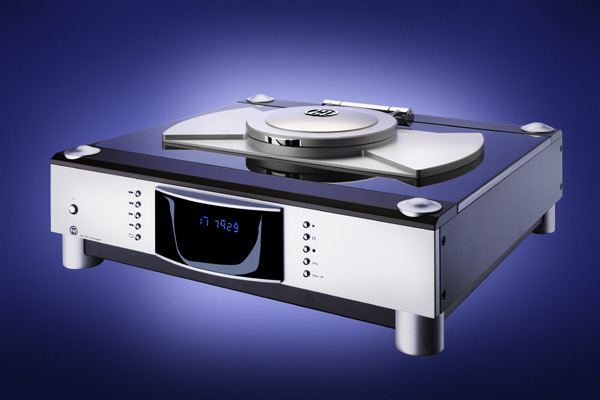
Credibility is sometimes a creeping phenomenon. It may start with some light buzz that hardly anyone takes seriously. Slowly a point of view gains traction, building momentum. Soon the tastemakers jump on board and one day, what do you know, what started as an unsupported idea is accepted as a fait accompli.
So it is with the poor little, under-appreciated digital transport. Tell me: when you think about improving your CD front-end, what's the first thing that comes to mind? Surely not the transport, I expect. More likely it would be the DAC, or even the digital cable.
Here's my tale of how two transports changed my mind, and stimulated some critical musings about the medium.
I got into digital late in the game. For the first fifteen years or so, I had nothing but four-letter words for the whole endeavor. When I eventually succumbed, I acquired a modified Philips player as a transport and a high-quality DAC. I wanted this front-end to sound like my Linn LP12 record player: the DAC and the modded Philips transport from von Gaylord Audio did.
The Philips lasted a while. Then I was introduced to the CEC TL1X belt-drive transport. Although I couldn't understand why a transport needed to be so big and heavy, there was no denying the Grand Canyon between it and the Philips. It was a no brainer to acquire the thing.
Digital products, mostly DACs and one-box players, came in for review and went back. I upgraded within the von Gaylord Audio family of DACs until I acquired the two-chassis UNI model. Along the way, I got the Zanden Audio Model 5000 Mk III tubed DAC. But nothing challenged the wonderful CEC TL1X transport. Hooked up to one of these reference DACs, the CEC stood firm against all comers: none offered sufficient cause to stir thoughts of replacement.
Between the long reign of the CEC and reinforcement from the audio magazines on the primacy of the DAC, the notion that transports play the minor role in CD playback became established in my mind. I was happy with my front-end and became complacent. There were plenty of bigger fish to fry elsewhere in my system. This was many years ago.
another Wakeup Call
This view of the world came unglued with a loan of the mbl 1521 A digital transport. Now the CEC stood on the near side of the canyon. This was a KO, and the CEC was flat out on the carpet.
Sob… sigh… so long CEC. I'm sure you know how the story goes along the long and winding road of upgrades. These experiences with the CEC and the mbl got me to reconsider the role of the transport. There's no question about the importance of the turntable in vinyl playback—it gets most of the attention. Well, how about the digital rotation mechanism and the laser pickup? Hey, maybe I could do a transport shoot-out for a future article? (I tried, but it proved too difficult to pull together—most manufacturers don't even offer separates anymore.)
the CEC TL1X sets the pace
Let's begin with the CEC TL1X, my reference at the time. First and foremost, it must be said this box makes music. Before the critical assessment kicks in, before you sit down for serious listening, even while it's burning-in, you can hear that.
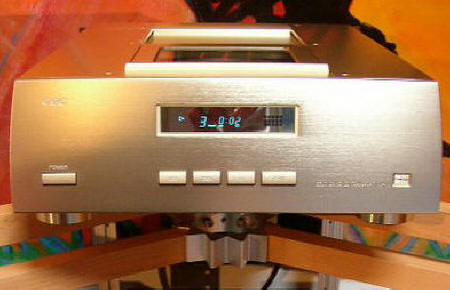
The CEC TL1X has a dark tonal palette and a huge amount of weight. It doesn't hurt that the machine is also warm and forgiving—like old-fashioned analogue. A lot of us credited its belt-drive mechanism, like that used in LP turntables, for imparting an analog feel. The TL1X has an affinity with unamplified acoustic sound, with an emphasis on acoustic.
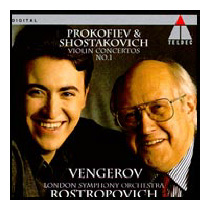
Let's cue up the Shostakovich Violin Concerto No. 1, with Maxim Vengerov as soloist and Rostropovich conducting the London Symphony Orchestra (TELDEC 4509-92256-2). This 1996 multiple Gramophone Award nominee impresses immediately with its holistic, seamless stage-front. It's all of a piece, cut from the same midrangey, warm cloth. There's a blending of the lower strings, and LOTS of weight, maybe not enough body. It seems a bit flat, dimensionally. There's no deep space—it's limited by excessive smoothness, which in turn is responsible for a lack of texture. (But remember, this is how it sometimes sounds in life). No stridency, no glare—it's kind of the reverse, not enough edge and nothing remotely approaching glare. Vengerov is standing in front, apart from the orchestra. There's barely a hint of bite on his violin: more would be better.
About nine minutes into the first movement the low strings start growling, giving the first indication of this machine's powerful, BIG low-end. While outsized, the bottom isn't spotlit—far from it. One thing you cannot fault is the CEC's frequency integration. Dynamics scale upwards step-less gradations. But it can also be reasonably subtle when called for. The second movement's flurry of winds reinforces the impression of better than average timbral portrayal, especially those overtones coming from lower frequencies. The first-class timbre compensates for some flattening of micro-dynamics and consequent loss of tone colors. Even though there are depth cues, the lack of surface texture presents a cranial challenge. I'm aware of my brain working to flesh out the stage, filling in the missing info.
Frequency response is basically flat up through the midrange. Within this, the progression is even and very well integrated. The top is reticent, causing the bottom to be outsized.
One other thing is worth noting: the TL1X does piano exceptionally true-to-life. I came across a BBC MUSIC MAGAZINE CD of Mieczyslaw Horszowski in a live piano recital from the 1983 Aldeburgh Festival (BBC MM112). I scarf up Horszowski recordings wherever I come across them. He must have been about 80 at the time of the recording. This was a treat: while he was alive, the man represented one of the few direct links to the bygone days of turn-of-the-last-century musical style. As far as the recording, it rings very true to my ear. Often piano playback exhibits excessive separation of notes and not enough case resonance. Most of the time there is too much of the frequency extremes and the instrument images as wide as your speakers are spread. (This is how engineers are taught to do it in recording schools.) The live instrument sounds thoroughly blended and very midrangy, which is precisely what the TL1X is putting out.
In sum, the TL1X is inordinately musical and easy to listen to, a bit blurry (or veiled), with good dynamics, and a total absence of stridency or glare. Its sound is unforced and certainly not Hifi. No longer in production, the last seen MSRP was $5,500, but you can sometimes find it on Audiogon for about $2,000. It remains a great buy at its price point; I don't know of a better transport for the money.
mbl 1521 A reporting for duty, sir
Then the mbl 1521 A Transport arrived. Ah, where to begin. Let's try the second movement of the Shostakovich Violin Concerto. On Vengerov's first notes, the sheer mass of new, vivid information makes me grab the CD case to check the label. Yup…. it's the same CD. Let's play that movement again.
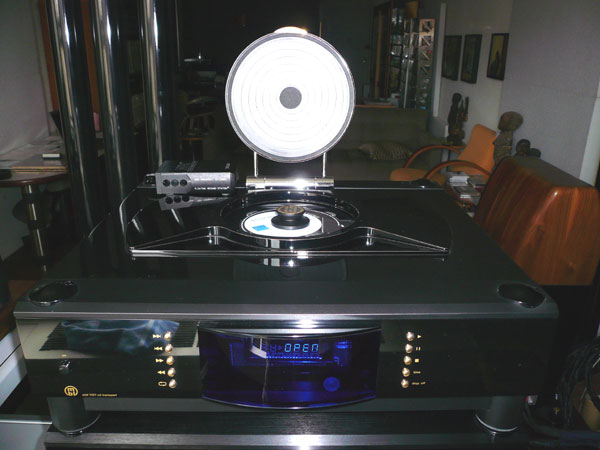
By Jove, each instrument in the multiple melodic lines is so complete, so fulfilled, you can pick and choose which to focus on at your whim. Very little mental effort is required. Crisp and direct with more edge detail, yet no sharply delineated boundaries, the mb's ability to provide separate, easy-to-follow lines owes much to its rendering of textural and timbral differences, rather than segregating images on the stage. There's no spotlighting. There's also less of the holistic blending as with the CEC, and no gravitation to the midrange. The mbl throws a huge amount of musical detail at you without losing the integrity of a single line.
I actually have a bit of a problem with this. After the TL1X, the "passive vividness" of the 1521 A Transport is a little surreal. It doesn't sound like Carnegie Hall—it seems too clear, too direct, it places you too close, what with all the detail. But let's look into that musical, holistic quality of the TL1X for a minute. That pleasing, homogenous surface actually has to do with a lack of texture and the flat surface—it casts everything in the same hue, or cloth. This is also why your brain has to work harder.
The second thing to note, and this may seem relatively small but made for a large cognitive shock, was the presentation of depth cues. There is layering with the CEC, instruments are arrayed into the distance, but they are flat—they have no individual extension front to back, they are missing 3-D cues. They seem like gobs of tone. Kind of reminds me of the splatter effects of a game of Paint Ball. The aftermath of the game is splats of color on your opponent's garment. The TL1X images are like 2D bursts of tone in space.
This realization was slow to mature. On the first round of comparisons, the two transports' space presentation didn't seem that far apart, but it grew on you. Once aware, it became obvious that the CEC's images are surface only; they don't have front-to-back projection. At that point, it became especially jarring going back and forth between the drives.
Curiously enough, I recently experienced this with the Sonic Euphoria passive preamp. Have you ever heard a passive preamp? The old McCormack TLC-1 used to be my reference. It's been so long, I was eager to get re-acquainted with the genre, but a brief visit was all I wanted after I observed its soundstage and found it… flat and lacking dimension, uncannily like the TL1X. I guess I've come a long way since then.
the mbl 1521 A in a Nut Shell
The 1521 A shares a great many of the mbl Noble line family traits I've described in my reviews of the 5011 preamp and 8011 AM monoblocks. To avoid repetition, I'll keep the general overview brief.
First, it is non-fatiguing. The 1521 A possesses an introvert personality type. Dynamics and resolution are way up there, but are presented in an unassuming manner. It prefers to be modest about its virtues, and leave it up to you to take notice.
Second, while the 1521 A's tonal palette is lighter and less warm than the CEC, it is still comparatively on the dark and warm side.
Third, frequency response is a model of linearity, with controlled and textured bass, full and proportionate allotments of body throughout the range, and a sweet, controlled treble. Images are large and fleshy without fat or looseness. The stage can seem a little thick due to the high information content and large images.
Fourth, the noise floor and artifacts are uncommonly low. When there's no signal, there's not a peep out of the speakers.
Fifth, it doesn't exhibit a solid-state grain structure. (Neither does the CEC.) Both have a smooth surface that somewhat impedes the rendering of texture. This is more of an issue with the CEC.
Wires and Burn-in
The top-loading 1521 A sounds midrangy and veiled for the first 50 or so hours. Then it becomes quite neutral and you might want to thaw it out a bit. The Kubala-Sosna Emotion balanced digital cable was an excellent match.
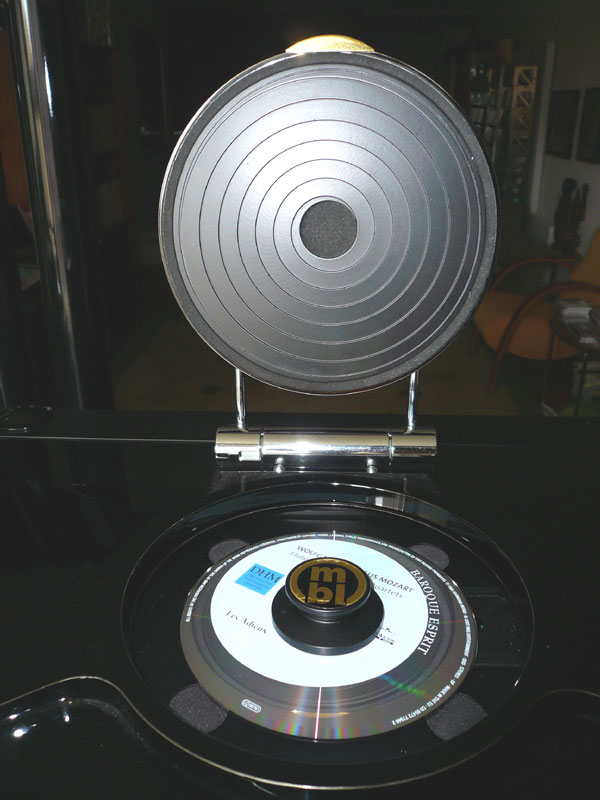
One quick note about how quickly the 1521 A mechanism stops spinning. The CD is ready to be removed in a second or two, much earlier than most transports—some keep you waiting as long as half-a-minute. Initial load time for the CD to register is about average.
Less is More
I have a very good, very expensive power conditioner, the TARA Labs IDAT. As a rule, front-end components are automatically plugged into it—and sound better that way. Now I was in for a pleasant surprise. Try running the mbl 1521 A right from the wall or via a power strip. Connected into the Ensemble outlet strip this way, the 1521 A had a nice relaxed and flowing quality, much life and immediacy, and no noticeable increase in digititus. While it sounds great right into the wall, there was a fall off in resolution and dynamic range, and it became softer. But you might like it this way.
Here's a tip that will give you more bloom and body, more bottom and presence: make sure you have only one digital cable connected to the mbl 1521 A at a time. Don't ask me why, but an XLR and a RCA sharing outputs compromised performance.
Want to radically alter the sound of the 1521 A? The transport is probably the most sensitive to the messenger carrying the incoming AC. Whatever the distinguishing characteristics of your PC, they will be doubly noticeable when used on the mbl. I didn't notice this effect particularly with the CEC, but with the mbl it was on the make or break level. With TARA Labs The One PC, we had full bandwidth, linear perfection, and a very neutral profile. The degree of warmth introduced by the Harmonix Studio Master was startling. It got warmer, thicker, less extended on top, and lost any trace of frostiness. Or use a Kubala-Sosna Emotion PC to warm up the sound to a degree midway between the other two.
Unblocked: the mbl 1511 D DAC arrives
Of course, in order to hear these differences in transports you must have a DAC up to the job: I had two, the Zanden and the vGA.
Then I was provided with a third: the mbl 1511 D DAC came in. This supported everything previously said about transports. As I have nothing further to add, you can jump to the Conclusion now, or stick with me if you want to hear about the mbl Noble Line DACs.
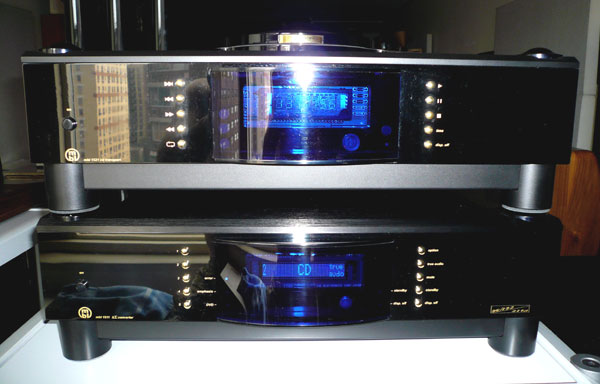
First, I switched to balanced mode, because mbl prefers it. The German DAC served up a wide cluster of improvements along the lines of pace, clarity, imaging, micro-dynamics and tighter bass, all reflecting its more accurate—and also more solid-state—voicing. The concert space it conjures would be Carnegie Hal's smaller venue, Zankel Hall, if only that poor hall had more bloom. (I'm thinking in terms of clarity and transparency.) Where the vGA is easy listening, the mbl demands your attention. It's hard to keep music in the background, even with the DACs introvert personality. It lets you hear everything—maybe too much.
It's interesting to note how the mbl front-end reproduced the piano. Each note is heard quite distinctly and there's less of the case resonance. It sounds like a different brand of piano, maybe even a fortepiano. The instrument is brighter, more in the upper midrange, less warm, and images smaller in center stage. It is also emotionally cooler. Now Mieczyslaw Horszowski is displaying admirable restraint. With the CEC and either of my reference DACs, I was entranced by his luxurious, regal bearing and relaxed pace.
the mbl 1511 F replacement
And still later on, I upgraded to the F version of the 1511 DAC, bringing me up to current spec. (This took me up two steps, from the D to the F. MSRP $9270.) Superficially, aside from the F being SACD ready and having some cosmetic changes, there was about 92% in common. The obvious differences in that 8% were along the lines of greater pacing, focus, depth and texture.
Less obvious was how these two 1511 DACs handled low-level signals. Before the upgrade, I was aware of a lack of vitality in low-level passages. I used to sit back, wondering "When is something dynamic gonna come along? Maybe it needs more volume?" These soft sections were somewhat flat dynamically and midrangy in terms of frequency.
I know what to attribute that problem to, because it went away with the F version. And now, with the 1511 F and 1521 A, I can truly say the mbl Noble front-end is one of the best examples of unforced dynamics I've come across. It stays open and composed regardless of signal level.
By the way, the F DAC sounds good after 50 hours, but you won't know what it's really capable of until its clocked a month of run time.
And that tip about having only one digital cable connected to the 1521 A at a time: the same is true for the 1511 DAC. Connecting any more than one cable in or out compromised performance. (Unsurprisingly, the mbl preamp follows suit, too. Try this: listen to whatever's in the first slot, marked CD 1. Then disconnect all other inputs and listen again.)
While we're at it, those outputs, or inputs, marked number one always sound better than those marked two, three, etc. Whatever's in that slot has an advantage (maybe due to shorter signal paths on the circuit board?). I didn't want to believe this, because it makes my life more complicated when doing comparisons, but it's true—I heard it all vividly demonstrated in my living room. For optimum performance, have only one source connected to the first input.
Degrees of Digititus: or, What's Wrong with Digital?
With the mbl stack I was enjoying unparalleled dynamics, signal to noise ratios, channel separation, bass control, soundstaging… the list goes on. There's no doubt in my mind the Noble Line of digital separates are of reference caliber and a best buy at their price (around $9K a piece). They are realistic and stunningly accurate.
As one visitor remarked, "The Noble Line of digital separates are terrific. They actually approach analog." He said that, and we all nodded in agreement, with the implicit understanding that digital is expected to come up short.
What's the problem with digital playback? We all talk about it, but nobody, to my knowledge, has taken the bait and spelled out just what those problems are. It's left quite vague and ill defined. I'd like to float a few preliminary ideas.
the First Degree
Let's turn back the clock to the early 1980's. The first generation of digital products arrived riddled with a cluster of symptoms, i.e. the razor-sharp treble transients that nearly took your ears off; the thin tone; the grainy texture; the hyped soundstage. Everybody either ran for the hills, or covered their ears and pretended not to notice. Eventually, we agreed to call this Digititus.
Today's machines are beyond this. I've heard current components at every price point with nary a trace of it. Listening to one of these newer products, you think, "Wow! Great tone and body! There's no stridency or edge to speak of." None of the aforementioned symptoms are in evidence. (But then, a surprising number err in a new way and suffer from over-compensation. They become too smooth, warm and fulsome to the point of flabbiness. The mbl 1511 F DAC has some of this. The Class D amps from NuForce exhibit a great deal of it.)
the Second Degree
So, we think the device has overcome Digititus. It is listenable, maybe even ingratiating. But with complex material, do you have trouble identifying what instrument is playing? If it is unclear, if you can't tell whether that's a clarinet or an oboe, something else is wrong… chances are you've got the second degree.
The second degree of Digititus is more subtle and pervasive—every digital front-end has it to some extent. It shows up in these ways:
1) Timbral insufficiency. Your brain struggles to know whether that's a clarinet or an oboe. Alas, there's no way this can be resolved. This is fallout from the way designers opted to fix the first symptoms of the disease, i.e. by using a subtractive solution; to take things away that they think won't be missed. Unfortunately, the target of these deletions is often slices of the timbral envelope. Put bluntly, with a reduced timbral spectrum, you will never resolve the instrument's identity.
The missing timbral information may also be inherent in the on/off nature of the encoding.
2) The surface of the soundstage is notably smooth. This was done to compensate for the first-degree burn. The harm done is reduced texture.
3) The leading edge of transients is soft. To eliminate the bleeding treble edge, it was blunted.
These are preliminary thoughts—somebody's got to get the discussion rolling. If you're confused at this point, do an A / B with analog. Don't listen to the things we know digital does better. An analog rig of even modest cost will not exhibit these three symptoms.
That statement, "The Noble Line of digital separates actually approaches analog," is the highest accolade you can toss at a digital component.
Conclusion
I began to get serious about digital late in the game. For the first fifteen or so years, I had nothing but four-letter words for the medium. Then I got a modded Philips player as a transport, along with some high-quality DACS. I wanted it to sound like my Linn LP12 record player: the von Gaylord Audio DACs and their modded Philips player do.
The Philips was summarily trumped by the briefest exposure to the CEC TL1X transport. (No longer available, the last MSRP was $5500. You can sometimes find one of these on the used market for about $2,000, or double the cost of the modded Philips.) The TL1X held its ground against all comers even as I upgraded DACs, which led me to think there wasn't much more to be gleaned from exploring transports. I was happy for a long while and became complacent, a position reinforced by the high-end media's focus on the DAC side of the equation.
Do things ever stay put?
The mbl 1521 A transport came in and took over. The difference between it and the CEC TL1X was about equal to that between the TL1X and the Philips player. The degree of truth rendered by the mbl 1521 A unquestionably puts it in Class A+. And once again the price point doubled, now up to $9,495.
The moral of the story is: Do not take your digital drive for granted. The transport is unsung in the high-end media and unjustifiably overlooked. Huge gains are available, if you seek out the right units. If you can afford it, the mbl 1521 A transport is definitely worth it.
MBL Akustikgeräte GmbH
web address:
www.mbl-germany.de
US distributor
mbl of America
6615 E. Sleepy Owl Way
Scottsdale, AZ 85262
TEL: 480. 563. 4393
